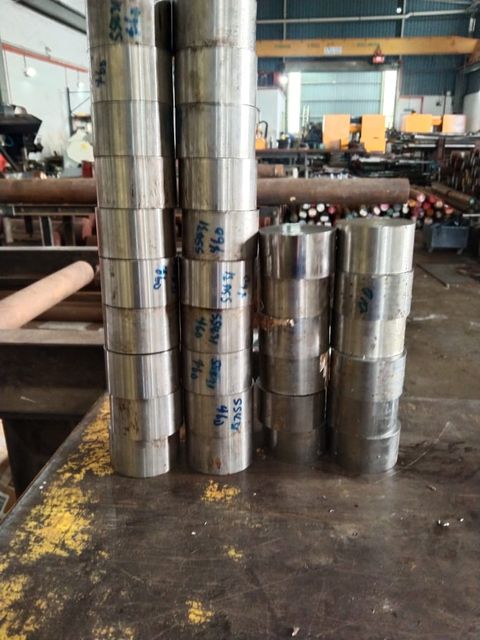Stainless Steel 431 | SUS431 | Stainless Steel Supplier Singapore | S43100 | 1.4057
Kali terakhir kemas kini
Harga:
R.F.Q
Share Product:
Butiran
E Steel Sdn Bhd - A Leading Supplier of Stainless Steel SUS431
Stainless Steel 431 (or known as SUS431)
Chemical Formula :
Fe, <0.20% | C, 15-17% | Cr, 1.25-2.50% | Ni, <1.00% | Mn, <1% | Si, <0.040% | P, <0.03% | S
----------
Background :
This heat treatable martensitic, nickel-bearing grade has the best corrosion resistance properties of all the martensitic grades. It has excellent tensile and torque strength, and good toughness, making it ideally suited to shafting and bolt applications. It can be hardened to approximately 40HRC. Because of its high yield strength, this grade is not readily cold worked and is therefore not recommended for use in operations such as cold heading, bending, deep drawing or spinning.
Martensitic stainless steels are optimised for high hardness, and other properties are to some degree compromised. Fabrication must be by methods that allow for poor weldability and usually also allow for a final harden and temper heat treatment. Corrosion resistance is lower than the common austenitic grades, and their useful operating temperature range is limited by their loss of ductility at sub-zero temperatures and loss of strength by over-tempering at elevated temperatures.
----------
Key Properties :
These properties are specified for bar product in ASTM A276. Similar but not necessarily identical properties are specified for other products such as plate and forgings in their respective specifications.
----------
Physical Properties :
| Grade | Density (kg/m3) | Elastic Modulus (GPa) | Mean Coefficient of Thermal Expansion (mm/m/°C) | Thermal Conductivity (W/m.K) | Specific Heat0-100°C (J/kg.K) | Electrical Resistivity (nW.m) | |||
| 0-100°C | 0-315°C | 0-538°C | at 100°C | at 500°C | |||||
| 431 | 7750 | 200 | 10.2 | 12.1 | – | 20.2 | – | 460 | 720 |
----------
Mechanical Properties :
| Tempering Temperature (°C) | Tensile Strength (MPa) | Yield Strength 0.2% Proof (MPa) | Elongation (% in 50mm) | Hardness Brinell (HB) | Impact Charpy V (J) |
| Annealed * | 862 | 655 | 20 | 285 max | – |
| 204 | 1345 | 1055 | 20 | 388 | 50 |
| 316 | 1295 | 1035 | 19 | 375 | 53 |
| 427 | 1350 | 1080 | 19 | 388 | # |
| 538 | 1140 | 965 | 19 | 321 | # |
| 593 | 1015 | 770 | 20 | 293 | 64 |
| 650 | 960 | 695 | 20 | 277 | 84 |
*Grade 431 is frequently stocked and supplied in “Condition T”, with specified tensile strength of 850 – 1000MPa.
* Annealed tensile properties are typical for Condition A of ASTM A276; annealed hardness is the specified maximum. Grade 431 is only rarely stocked in annealed Condition A.# Due to associated low impact resistance this steel should not be tempered in the range 425-600°C
----------
Grade Specification Comparison :
| Grade | UNS No | Old British | Euronorm | Swedish SS | Japanese JIS | null | |
|---|---|---|---|---|---|---|---|
| BS | En | No | Name | null | |||
| 431 | S43100 | 431S29 | 57 | 1.4057 | X17CrNi16-2 | 2321 | SUS 431 |
*These comparisons are approximate only. The list is intended as a comparison of functionally similar materials not as a schedule of contractual equivalents. If exact equivalents are needed original specifications must be consulted.
----------
Possible Alternative Grades :
| Grade | Why it might be chosen instead of 431 |
| 410 | Only a lower hardened strength is needed. |
| 416 | High machinability is required, and the lower hardened strength and lower corrosion resistance of 416 is acceptable. |
| 440C | A higher hardened strength or hardness than can be obtained from 420 is needed. |
----------
Corrosion Resistance :
Excellent resistance to a wide variety of corrosive media. Reasonable resistance to salt water in cold southern waters but less resistant than Grade 316 in tropical waters. Overall the corrosion resistance of 431 is approximately the same as or slightly below that of grade 304.
Performance is best with a smooth surface finish, in the hardened and tempered condition.
----------
Heat Resistance :
Resists scaling in intermittent service to 925°C and in continuous service to 870°C, but is generally not recommended for use in temperatures above the relevant tempering temperature, because of reduction in mechanical properties.
----------
Heat Treatment :
Full anneal – not practical for this grade – it hardens even when cooled slowly.
Process Anneal – heat to 620-660°C and air cool.
Hardened by heating to 980-1065°C, holding for about 1/2 hour then quenching in air or oil. Pre-heating at 760-790°C may be useful for complex parts or those already hardened. Temper to suit mechanical requirements, at temperatures as indicated in the accompanying table.
The tempering range 425-600°C should be avoided due to reduced impact toughness, although the effect is less marked than in most other martensitic grades.
----------
Welding :
Welding is difficult due to cracking. A pre-heat of 200-300°C is recommended prior to welding. Grade 410 filler rod can be used, but Grades 308L, 309 or 310 will provide more ductile welds, so long as matching properties are not required. Post-weld heat treat at 650°C.
----------
Machining :
In the annealed condition this grade is relatively easily machined, but if hardened to above 30HRC machining becomes more difficult.
----------
Applications :
Typical applications include:
- Nuts and bolts
- Propeller shafting
- Pump shafts
- Beater bars
- Marine hardware
- Laboratory benches & equipment
Spesifikasi
| Kata kunci | |
| Jenama |
Katalog Download

